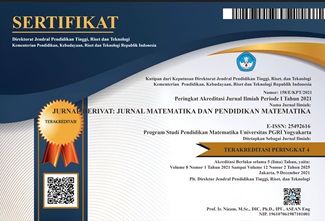Minimum Spanning Tree Rute Shopping Mall Di Surabaya Menggunakan Algoritma Prim
DOI:
https://doi.org/10.31316/jderivat.v11i1.4955Abstract
Surabaya as the second most populous city in Indonesia often carries out developments on land, one of which is the construction of a shopping center. The large number of shopping center developments has made both local and foreign residents want to visit shopping centers in Surabaya. There are 9 most popular shopping centers used in this study. The purpose of this research is to determine the shortest route between shopping centers in Surabaya by using the prim algorithm. This algorithm determines the shortest route by forming a minimum spanning tree. The results obtained in this study are the shortest travel time from 9 shopping centers is 81 minutes with a distance of 31.5 KM.
Keyword: Prim Algorithm, Graph, Rute, Surabaya
References
Akhirina, T. Y., & Afrizal, T. (2020). Pendekatan Matriks Ketetanggaan Berbobot untuk Solusi Minimum Spanning Tree (MST). STRING (Satuan Tulisan Riset Dan Inovasi Teknologi), 4(3), 280. https://doi.org/10.30998/string.v4i3.5900
Barahama, R. M., Montolalu, C. E. J. C., & Tumilaar, R. (2021). Eksentrisitas Digraf pada Graf Gir Menggunakan Algoritma Breadth First Search. D’Cartesian: Jurnal Matematika Dan Aplikasi, 10(1), 31–36.
Fachrurrazi, S. (2018). Sistem Penentuan Rute Yang Tepat Dalam Sebuah Labirin Dengan Menerapkan Algoritma Prim. Sisfo: Jurnal Ilmiah Sistem Informasi, 2(1), 51–67. https://doi.org/10.29103/sisfo.v2i1.1003
Hari Sumardi, Afnaria, S. P. (2021). Pengembangan Algoritma Prim Untuk Menentukan Minimum Spanning Forest. Jurnal Matematika Dan Pendidikan Matematika, 4, 80–90.
Kusmira, M., & Taufiqurrochman. (2017). Pemanfaatan Aplikasi Graf Pada Pembuatan Jalur Angkot 05 Tasikmalaya. Seminar Nasional Sains Dan Teknoligi, 11, 1–6.
Kusuma, R. D., Purnomo, E. P., & Kasiwi, A. N. (2020). Analisis Upaya Kota Surabaya Untuk Mewujudkan Kota Hijau. April.
Lusiani, A., Sartika, E., Habinuddin, E., Binarto, A., Azis, I., & Kunci, K. (2021). Algoritma Prim dalam Penentuan Lintasan Terpendek dan Lintasan Tercepat pada Pendistribusian Logistik Bulog Jawa Barat. 4–5.
Makalew, R. A. M., Montolalu, C. E. J. C., & Mananohas, M. L. (2021). Lintasan Hamiltonian pada Graf 4-Connected. D’CARTESIAN, 9(2), 181. https://doi.org/10.35799/dc.9.2.2020.29735
Nugraha, D. W. (2011). Aplikasi Algoritma Prim untuk Menentukan Minimum Spanning Tree Suatu Graf Berbobot Berorientasi Objek. Teknik Elektro UNTAD Palu, 1(2), 70–79.
Rahardjo, B., Mochtar, I. B., & Widyastuti, H. (2017). Pengembangan Infrastruktur Jaringan Jalan Rel di Surabaya Metropolitan Area. IPTEK Journal of Proceedings Series, 3(5), 71–74. https://doi.org/10.12962/j23546026.y2017i5.3116
Sari, A. M., Sari, D. F., & Wibawani, S. (2020). Penerapan Konsep Walkability Dalam Mendukung Kota Surabaya Sebagai Kota Metropolitan Yang Produktif Dan Berkelanjutan. Public Administration Journal of Research, 2(3). https://doi.org/10.33005/paj.v2i3.58
Syahputra, E. R. (2016). Analisis Perbandingan Algoritma Prim dengan Algoritma Dijkstra dalam Pembentukan Minimum Spanning Tree ( MST ). Jurnal Teknik Informatika Unika St. Thomas (JTIUST), 01(02), 50–55.
Yasin, M., & Afandi, B. (2014). Simulasi Minimum Spanning Tree Graf Berbobot menggunakan Algortma Prim dan Algoritma Kruskal. Eucazione, 2(2), 121–130.
Downloads
Published
Issue
Section
Citation Check
License
Copyright (c) 2024 Nabila Tasya Amalia, Fahriza Novianti, Yasirah Rezqita Aisyah Yasmin

This work is licensed under a Creative Commons Attribution-ShareAlike 4.0 International License.
Authors who publish with this journal agree to the following terms:
-
Authors retain copyright and grant the journal right of first publication with the work simultaneously licensed under a Creative Commons Attribution-ShareAlike 4.0 International License that allows others to share the work with an acknowledgment of the work's authorship and initial publication in this journal.
- Authors are able to enter into separate, additional contractual arrangements for the non-exclusive distribution of the journal's published version of the work (e.g., post it to an institutional repository or publish it in a book), with an acknowledgment of its initial publication in this journal.
- Authors are permitted and encouraged to post their work online (e.g., in institutional repositories or on their website) prior to and during the submission process, as it can lead to productive exchanges, as well as earlier and greater citation of published work (See The Effect of Open Access).







